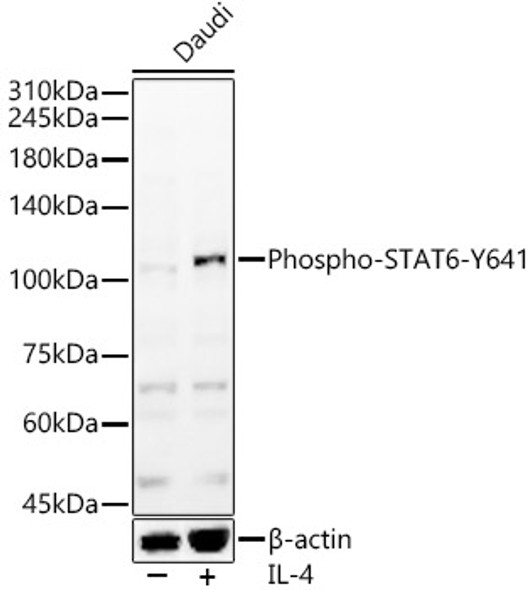Epigenetics & Nuclear Signaling Antibodies 4
Anti-Phospho-STAT6-Y641 Antibody (CABP0456)
- SKU:
- CABP0456
- Product Type:
- Antibody
- Applications:
- WB
- Applications:
- IHC
- Reactivity:
- Human
- Host Species:
- Rabbit
- Isotype:
- IgG
- Research Area:
- Epigenetics and Nuclear Signaling
Description
| Antibody Name: | Anti-Phospho-STAT6-Y641 Antibody |
| Antibody SKU: | CABP0456 |
| Antibody Size: | 20uL, 50uL, 100uL |
| Application: | WB |
| Reactivity: | Human |
| Host Species: | Rabbit |
| Immunogen: | A phospho specific peptide corresponding to residues surrounding Y641 of human STAT6 |
| Application: | WB |
| Recommended Dilution: | WB 1:500 - 1:2000 |
| Reactivity: | Human |
| Positive Samples: | HeLa |
| Immunogen: | A phospho specific peptide corresponding to residues surrounding Y641 of human STAT6 |
| Purification Method: | Affinity purification |
| Storage Buffer: | Store at -20°C. Avoid freeze / thaw cycles. Buffer: PBS with 0.02% sodium azide, 50% glycerol, pH7.3. |
| Isotype: | IgG |
| Sequence: | Email for sequence |
| Gene ID: | 6778 |
| Uniprot: | P42226 |
| Cellular Location: | Cytoplasm, Nucleus |
| Calculated MW: | 74kDa/81kDa/94kDa |
| Observed MW: | 110kDa |
| Synonyms: | D12S1644, IL-4-STAT, STAT6B, STAT6C, STAT6 |
| Background: | The protein encoded by this gene is a member of the STAT family of transcription factors. In response to cytokines and growth factors, STAT family members are phosphorylated by the receptor associated kinases, and then form homo- or heterodimers that translocate to the cell nucleus where they act as transcription activators. This protein plays a central role in exerting IL4 mediated biological responses. It is found to induce the expression of BCL2L1/BCL-X(L), which is responsible for the anti-apoptotic activity of IL4. Knockout studies in mice suggested the roles of this gene in differentiation of T helper 2 (Th2) cells, expression of cell surface markers, and class switch of immunoglobulins. Alternative splicing results in multiple transcript variants. |
| UniProt Protein Function: | STAT6: transcription factor of the STAT family. Plays a central role in IL4-mediated biological responses. Induces the expression of BCL2L1/BCL-X(L), which is responsible for the anti-apoptotic activity of IL4. May function in the differentiation of T helper 2 cells and class switch of immunoglobulins. Forms homo- or heterodimers that translocate into the nucleus where they regulate transcription. |
| UniProt Protein Details: | Protein type:DNA-binding; Transcription factor Chromosomal Location of Human Ortholog: 12q13 Cellular Component: cytoplasm; cytosol; lipid raft; nuclear chromatin; nucleoplasm Molecular Function:identical protein binding; protein binding; protein phosphatase binding; signal transducer activity; transcription factor activity Biological Process: mammary gland epithelial cell proliferation; negative regulation of T-helper 2 type immune response; negative regulation of transcription from RNA polymerase II promoter; positive regulation of interferon type I production; positive regulation of isotype switching to IgE isotypes; positive regulation of transcription from RNA polymerase II promoter; regulation of cell proliferation; regulation of transcription from RNA polymerase II promoter; signal transduction; T-helper 1 cell lineage commitment; transcription, DNA-dependent |
| NCBI Summary: | The protein encoded by this gene is a member of the STAT family of transcription factors. In response to cytokines and growth factors, STAT family members are phosphorylated by the receptor associated kinases, and then form homo- or heterodimers that translocate to the cell nucleus where they act as transcription activators. This protein plays a central role in exerting IL4 mediated biological responses. It is found to induce the expression of BCL2L1/BCL-X(L), which is responsible for the anti-apoptotic activity of IL4. Knockout studies in mice suggested the roles of this gene in differentiation of T helper 2 (Th2) cells, expression of cell surface markers, and class switch of immunoglobulins. Alternative splicing results in multiple transcript variants.[provided by RefSeq, May 2010] |
| UniProt Code: | P42226 |
| NCBI GenInfo Identifier: | 1174459 |
| NCBI Gene ID: | 6778 |
| NCBI Accession: | P42226.1 |
| UniProt Secondary Accession: | P42226,Q5FBW5, Q71UP4, A8K316, B7ZA27, F5GXI9, |
| UniProt Related Accession: | P42226 |
| Molecular Weight: | |
| NCBI Full Name: | Signal transducer and activator of transcription 6 |
| NCBI Synonym Full Names: | signal transducer and activator of transcription 6 |
| NCBI Official Symbol: | STAT6 |
| NCBI Official Synonym Symbols: | STAT6B; STAT6C; D12S1644; IL-4-STAT |
| NCBI Protein Information: | signal transducer and activator of transcription 6 |
| UniProt Protein Name: | Signal transducer and activator of transcription 6 |
| UniProt Synonym Protein Names: | IL-4 Stat |
| Protein Family: | Signal transducer and transcription activator |
| UniProt Gene Name: | STAT6 |
| UniProt Entry Name: | STAT6_HUMAN |







